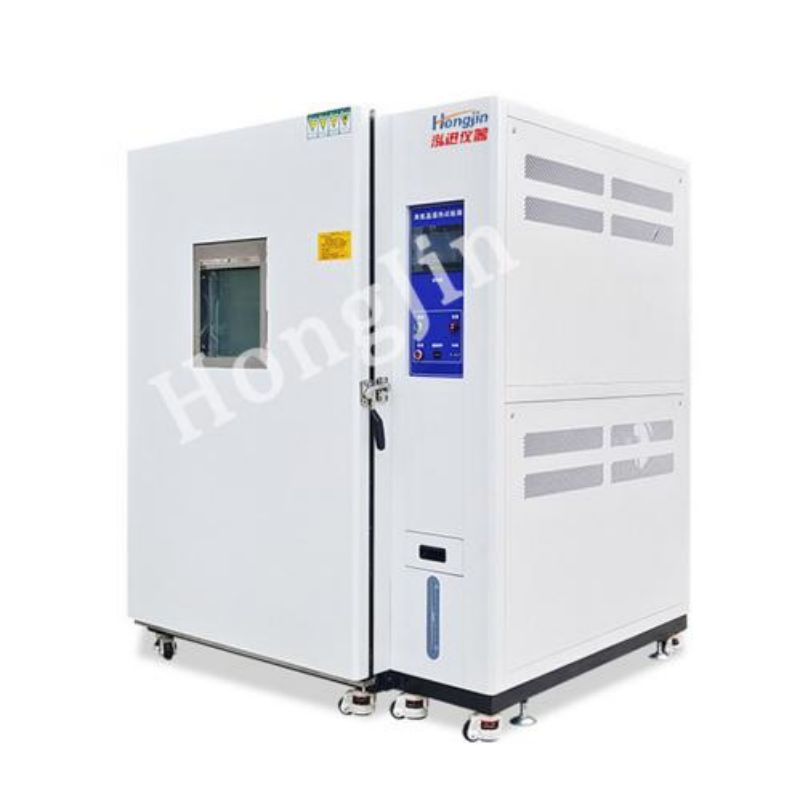The constant temperature and humidity test chamber is a device used to test the performance of materials in various environments and to test their heat resistance, cold resistance, dry resistance, and moisture resistance. Suitable for quality testing of products such as electronics, electrical, mobile phones, communication, instruments, vehicles, plastic products, metals, food, chemical, building materials, medical, aerospace, etc.
The constant temperature and humidity test box produced by our company has a high-quality appearance, with an arc-shaped body and a surface treated with fog stripes. It is flat and has no reaction handle, making it easy to operate, safe and reliable. In the rectangular laminated glass observation window, it can be used for testing and observation. The window is equipped with an anti sweat electric heater device to prevent water condensation and water droplets, and high brightness PI fluorescent lamps are used to maintain indoor lighting. Equipped with testing holes, it can be connected to external testing power or signal cables and adjustable trays. The double layer sealing of the door can effectively isolate internal temperature leakage. Equipped with an external water supply system, it is convenient to supplement the humidifier drum water supply and automatically recycle it. Built in mobile pulley, easy to move and place, and has a secure positioning screw for fixation.
The compressor circulation system adopts the French “Taikang” brand, which can effectively remove the lubricating oil between the condenser tube and the capillary tube. It uses the American Lianxing Environmental Refrigerant (R404L)
The controller adopts an original imported 7-inch touch screen, which can simultaneously display measured and set values. The temperature and humidity test conditions are programmable, and the test data can be directly exported through USB. The maximum recording time is 3 months.
Six major architectures of constant temperature and humidity test chambers
The constant temperature and humidity test chamber has six main structures, which are:
1. Sensor
Sensors mainly include humidity and temperature sensors. The most commonly used temperature sensors are platinum electrodes and thermal resistors. There are two methods for measuring environmental humidity: the dry hygrometer method and the solid-state electronic sensor immediate measurement method. Due to the low measurement accuracy of the wet zone ball method, current constant temperature and humidity chambers are gradually replacing wet zone balls with solid sensors for accurate measurement of environmental humidity.
2. Exhaust circulation system
The gas circulation is composed of a centrifugal fan, a cooling fan, and an electric motor that drives its operation under all normal conditions. It provides a circulation system for the gas in the experimental chamber.
3. Heating system
The heating system software of the environmental test chamber is very simple to operate relative to the refrigeration unit. It is mainly composed of high-power resistance wires. Due to the high temperature rise speed specified in the environmental test box, the output power of the heating system software in the environmental test box is relatively high, and an electric heater is also installed on the bottom plate of the environmental test box.
4. Control system
The automatic control system is the key to a comprehensive environmental test chamber, which determines the key indicators such as temperature raising speed and precision. Nowadays, the control board of the environmental test chamber mostly uses PID control, and a small part uses the operation method composed of PID and controller design. Because the automatic control system is mostly within the scope of mobile software, and this part is used throughout the entire application process, Difficulties are generally not easy to occur.
5. Cooling system
The refrigeration unit is an important part of a comprehensive environmental test chamber. Generally speaking, the cooling method is mechanical equipment cooling and auxiliary liquid nitrogen cooling. The mechanical equipment cooling uses steam reduction cooling, which is mainly composed of a refrigeration compressor, a cooler, a throttle valve organization, and an air conditioning evaporator. The refrigeration unit of the constant temperature and humidity box consists of two parts, each referred to as the high temperature part and the ultra-low temperature part. Each part is a relatively separate refrigeration unit. The volatilization, digestion, and absorption of the cold coal in the high temperature part come from the heating and gasification of the ultra-low temperature part of the refrigerant, while the volatilization of the ultra-low temperature part of the refrigerant is obtained through the endothermic reaction of the target being cooled/gas in the experimental chamber to obtain refrigeration capacity. The high temperature part and the ultra-low temperature part are connected by a volatile cooler between them, which is both the cooler for the high temperature part and the cooler for the ultra-low temperature part.
6. Environmental humidity
The temperature system software is divided into two subsystems: humidification and dehumidification. The humidification method generally adopts the steam humidification method, and the bottom pressure steam is immediately introduced into the laboratory space for humidification. This type of humidification method has the ability to increase humidity, faster speed, and flexible humidification operation, especially when it is very easy to complete mandatory humidification during temperature reduction.
Post time: Oct-13-2023

